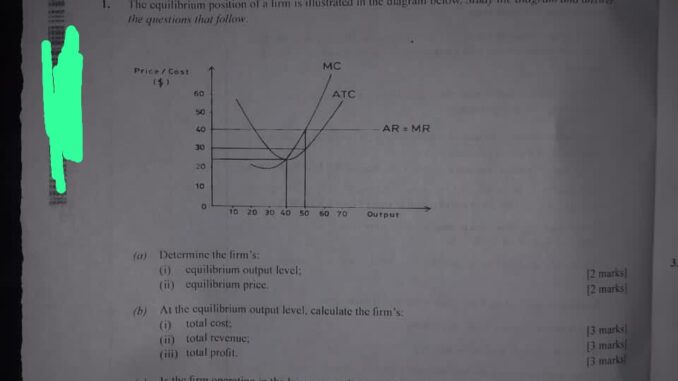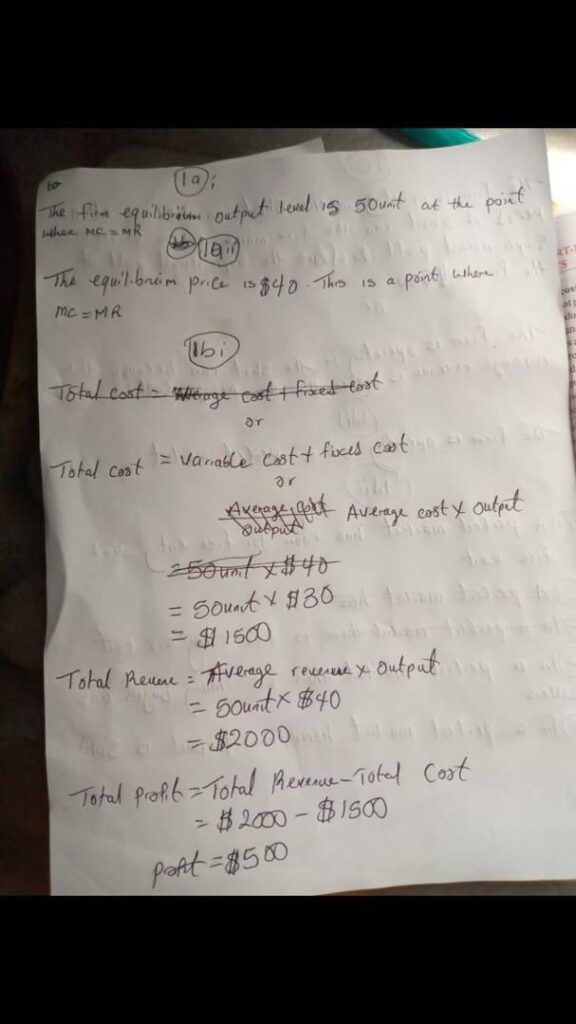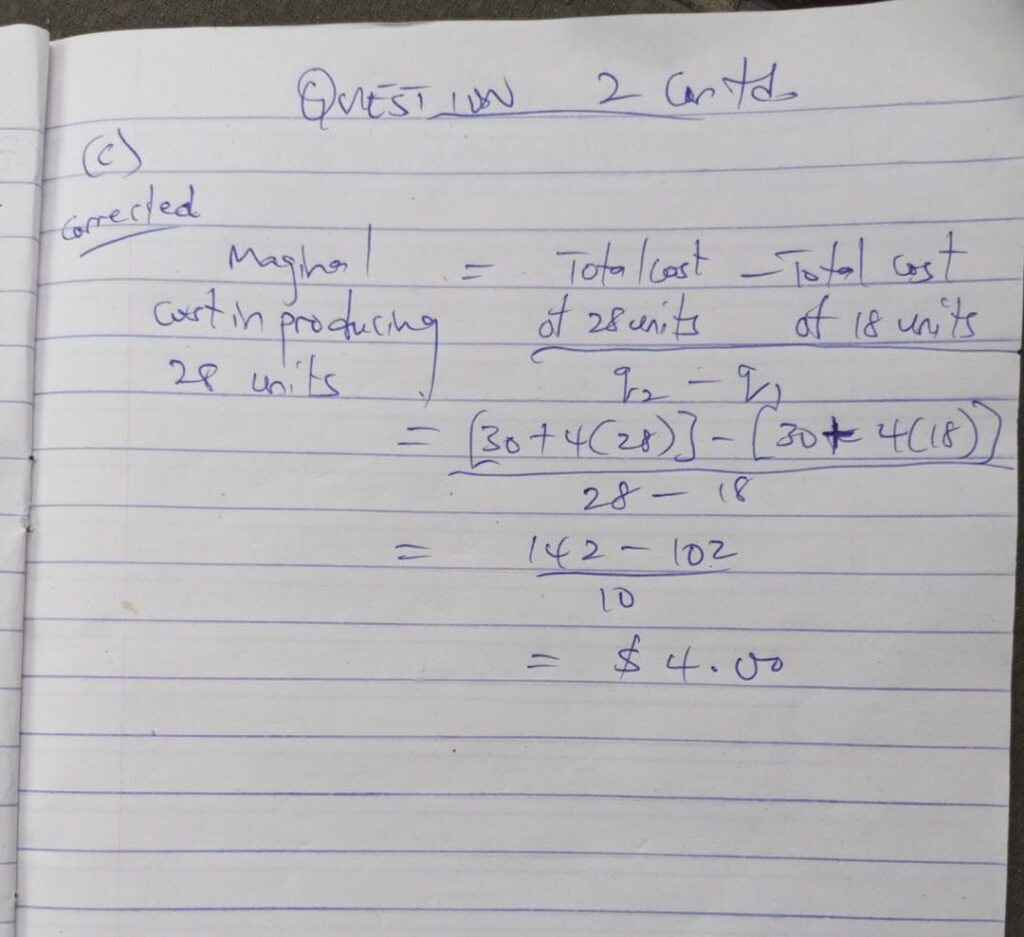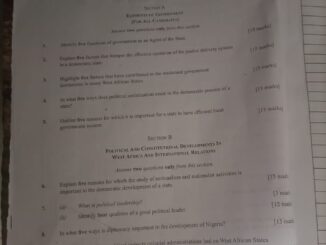
Waec 2023 Economics OBJ:-ExamgrandComNg
01DBDDACACBA
11CCACDDCBDC
21BDBCABCDBC
31AABCACCCAC
41BBDBDCBDBC
Completed by Examgrand
========================================
ECONOMICS QUESTION !!!!!



WAEC 2023 ECONOMICS ANSWERS;-ExamgrandComNg!!!!
(NO 1)


(2)

(Cont’d)

=======================================
(3ai)
Money cost refers to the actual monetary expenditure or price of a particular good, service, or resource, for example, if you purchase a smartphone for N50,000, the money cost is N50,000 WHILE Opportunity cost refers to the value of the next best alternative forgone when making a decision. For example, if you choose to buy the smartphone for N50,000, the opportunity cost could be the vacation you could have taken with that money or the other items you could have purchased.
(3aii)
Normal goods are goods for which demand increases as consumer income rises, and demand decreases as consumer income falls. Examples include luxury goods, such as high-end cars, designer clothing, or gourmet food WHILE Inferior goods are goods for which demand decreases as consumer income rises, and demand increases as consumer income falls. Examples of inferior goods include generic store-brand products, low-cost fast food, or public transportation.
(3bi)
INDIVIDUALS:
The scale of preference assist individuals in making efficient allocations of their resources by providing a framework for prioritization, resource allocation, considering opportunity costs, rational decision-making, and adaptability.
(3bii)
FIRMS:
The scale of preference assists firms in making efficient resource allocation decisions by providing a systematic framework to identify preferences, allocate scarce resources, analyze opportunity costs, optimize returns on investment, and adapt to changing circumstances.
(3biii)
GOVERNMENT:
The scale of preference assists governments in making efficient allocations of their resources by considering the priorities, preferences, and needs of the population.
=======================================
4a)
An economic system is a set of institutions, laws, and customs that determines how economic decisions are made, how goods and services are produced and distributed, and how resources are allocated in a society.
4b)
(i) Aim of production: In a capitalist economy, the aim of production is to maximize profit, while in a socialist economy, the aim of production is to meet the needs of society and ensure social welfare.
(ii) Consumer sovereignty: In a capitalist economy, consumer sovereignty is the principle that consumers determine what goods and services are produced through their purchasing decisions. In a socialist economy, the government determines what goods and services are produced based on the needs of society.
(iii) Competition: In a capitalist economy, competition is encouraged as a means of promoting innovation, efficiency, and consumer choice. In a socialist economy, competition is often discouraged or eliminated in favor of cooperation and collective ownership of the means of production.
4c)
(i) Land is a natural resource that is fixed in supply and cannot be created by human effort.
(ii) Land is heterogeneous, meaning that different parcels of land have different qualities, such as soil fertility, mineral deposits, and climate, that affect their productivity.
(iii) Land is subject to the law of diminishing returns, meaning that as more and more of the other factors of production (labor and capital) are applied to a given parcel of land, the marginal productivity of those factors will eventually decline.
=======================================
(5a)
A sole proprietorship is a business model where an individual is an owner as well as the operator of the business Whereas A partnership is a business model where two or more persons agree to carry on business and share profits and losses mutually.
(5b)
(i) Sole owner of the business
(ii) Unlimited liability
(iii) No legal entity
(iv) Sole decision maker
(5c)
(i) Generation of Income through Public Issue of Shares: One of the major channels through which Public Limited Companies generate capital is y selling shares to the public.
(ii) Security for Loan Advancement: Public Limited Companies can obtain and secure loans using the assets of the company as security as opposed to using the personal assets of the members.
(iii) Spreading Risks of Ownership: Because a Public Limited Company allows for pubic and unlimited membership, the risk of ownership is then spread amongst many people as opposed to being centered on a few as in the case of a Private Limited Company.
(iv) Separate Legal Identity: A duly incorporated Public Limited Company has an identity entirely different from that of the members. This means that the company is capable of independent existence and can enter into contractual transactions, acquire and own properties, and has the legal capacity to sue and be sued in its own name.
=======================================
6a)
Location of industry may be defined simply as the siting or establishment of a firm or industry in a particular place. An industry may be established either by individuals or government. either for economic or political reasons. In locating an industry in a particular area, one must bear in mind that the cost of production must be at the lowest level in order to ensure the continued existence of such an industry.
6b)
(i) Raw materials: A firm may choose to locate near sources of raw materials in order to reduce transportation costs and gain a competitive advantage in terms of cost of production. For example, a steel mill may choose to locate near iron ore deposits to reduce transportation costs.
(ii) Market: A firm may choose to locate near its target market in order to reduce transportation costs and gain a competitive advantage in terms of delivery time. For example, a supermarket chain may locate its stores in areas with high population density to maximize its customer base.
(iii) Government policy: Government policies such as tax incentives, subsidies, and regulations can influence the location decisions of firms. For example, a government may offer tax breaks to firms that locate in certain regions or industries in order to promote economic development.
6c)
(i) Reduced transportation costs: When firms locate near their sources of raw materials and target markets, they can reduce transportation costs, which can improve their competitiveness and profitability.
(ii) Increased efficiency: Localization of industry can lead to the development of industrial clusters, which are geographic concentrations of interconnected firms and supporting institutions. These clusters can promote the sharing of knowledge and resources, leading to increased efficiency and innovation.
(iii) Job creation: Localization of industry can create jobs in the local economy, which can have positive spillover effects on the community, such as increased consumer spending and tax revenues.
=======================================
7a. Gross domestic product (GDP): This is the total market value of final goods and services produced in a country at a particular period of time. In calculating the GDP of a country, no account is taken of the nationality of those that produce the goods and services.GDP is used in determining whether the country concerned is experiencing economic growth,decline or stagnation.
7b. Output method: The output method of measuring the gross domestic product involves summing up the market values of all output of the economy, sector by sector. Measurement is done using the value added method. Value added is defined as the value of output, less cost of input. In this method, national income is measured by adding together the value of enterprises which include individuals, firms and the government. Output method is also called net product or added value method.
7c. *Pick any three*
(1) Insufficient technical expertice:Thetechnical expertise, which is an essential element for collecting and analysing data,is insufficient.
(2) Problem of double counting: Some goods can be counted twice and this gives false national income estimates.
(3) Subsistence production:Thepredominance in the Nigerian economy of subsistence production,e.g.farming,tailoring and carpentry, makes estimation difficult.
(4) Problems of inflation: The national income figures can be over- or under-estimated as a result of inflation or deflation.
(5) Inability to quantify some services:Some services are not easily quantified,thereby affecting the national income estimates, e.g. housewives’ services.
(6) Difficulties in estimating net valuation: There are difficulties in estimating the value of net income from abroad. This is because many individuals may be involved,hence making accurate assessment impossible.
=======================================
(8a)
Embargo is a government-imposed restriction on trade or other economic activity with a particular country or group of countries. This restriction may include prohibiting or reducing imports, exports, financial transactions and/or travel to and from the targeted country.
(8b)
(i) Protection of Domestic Industries: Governments may impose tariffs to protect domestic industries from foreign competition. When foreign goods are imported at lower prices, it can lead to a decline in sales of similar domestically produced products. Tariffs can be seen as a way to make imports more expensive, thereby providing protection for local businesses and industries.
(ii) Generating Revenue: Tariffs on imports can generate revenue for governments. This revenue can be used to fund various government programs, infrastructure projects, or to reduce budget deficits.
(iii) National Security: Governments may impose tariffs on imports to protect national security interests. This could include limiting the import of goods that are critical to national defense or that could pose a threat to public safety. In times of war or economic conflict, tariffs can be seen as a way to preserve national interests and protect the country’s economy from foreign influence.
(8c)
[PICK ANY THREE]
(i) Inflation: Tariffs can cause inflation, as domestic producers will be able to charge higher prices due to reduced competition from imports. This can ultimately result in higher prices for consumers, reducing their purchasing power and overall economic growth.
(ii) Retaliation: When a country imposes tariffs on another country’s imports, the other country may respond by imposing tariffs of its own on the first country’s exports. This can lead to a trade war, which harms both countries and global economic growth.
(iii) Reduced Efficiency: Tariffs can lead to reduced efficiency in the market, as domestic companies may become less productive and innovative due to reduced competition from imports. This can ultimately harm the industry as a whole and reduce economic growth.
(iv) Unfairness: Tariffs can be unfair, as they may favor certain domestic industries over others. This can lead to a lack of competition in certain industries, which ultimately harms consumers through higher prices and reduced innovation.
(v) Increased Costs of Living: Tariffs can significantly increase the cost of living for many people, as they increase the prices of imported consumer goods. This can disproportionately impact the poor, who may have limited options for purchasing basic necessities.
======================================





Be the first to comment